# German Spitz Gross
Text
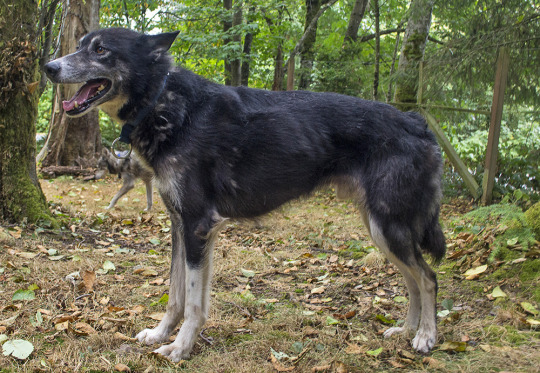


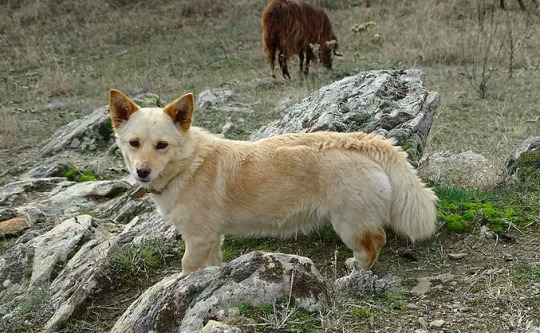

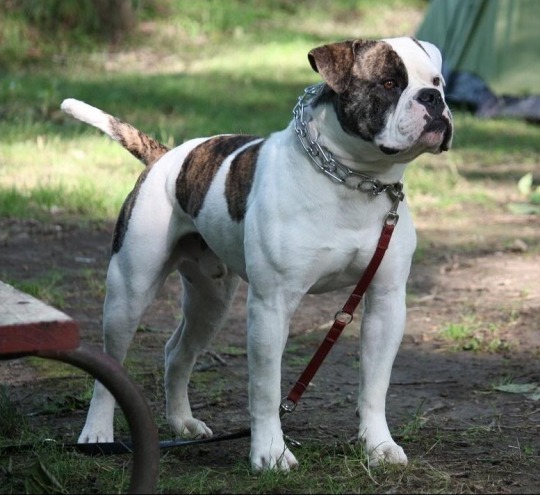
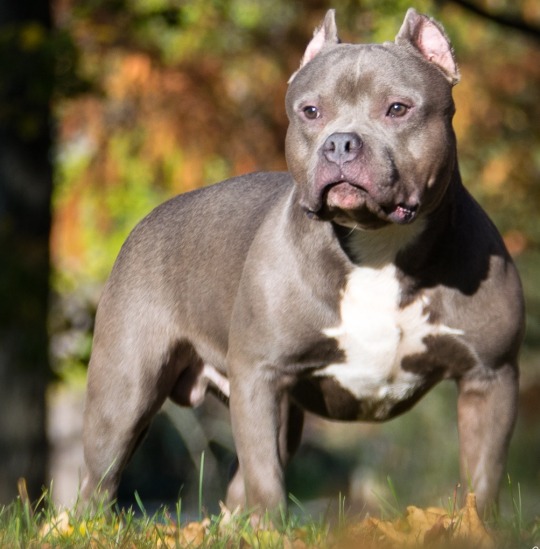
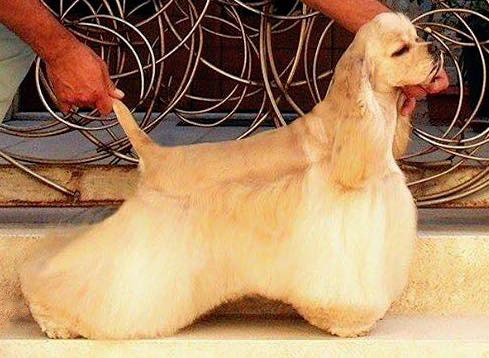

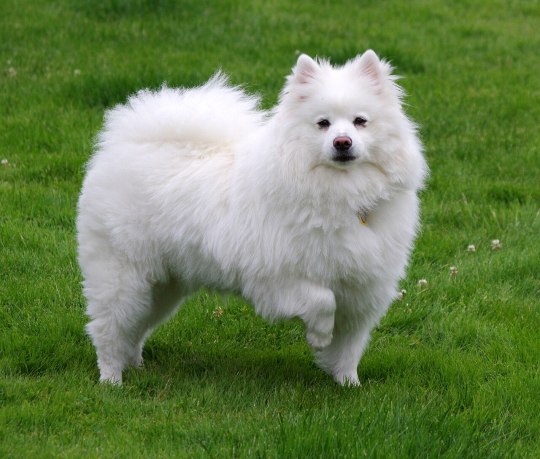
#alaskan husky#husky#alaskan klee kai#Alaskan Malamute#Alopekis#poll#polls#dog#dog breeds#Alpine Dachsbracke#American Bulldog#american bully#American Cocker Spaniel#American English Coonhound#american eskimo dog# German Spitz Gross#preliminary round
1 note
·
View note
Text
American Eskimo dog price, size, behavior & Profile Special Info…
The American Eskimo Dog is a breed of companion dog that originated in Germany. The American Eskimo Dog is a member of the Spitz family. It is considered an ancient dog breed due to its recent mixing with wolves.
The ancestor of the breed was the German Spitz, but due to anti-German sentiment during World War I, it was renamed “American Eskimo Dog”. Although modern American Eskimo dogs have been exported as German Spitz Gross, the breeds have diverged and the standards vary greatly.
In addition to serving as a watchdog and companion, the American Eskimo dog achieved a high level of popularity in the United States as a circus performer in the 1930s and 1940s.
There are three size varieties of the American Eskimo dog breed, Toy, Miniature, and Standard. They share a close resemblance with the Japanese Spitz, Danish Spitz, Volpino Italiano, German Spitz, Indian Spitz, and Samoyeds.
Visual Status:
Dog Breed Group:
Companion DogsHeight:
15 to 19 inches tall at the shoulderWeight:
Starts at 30 poundsLife Span:
12 to 15 years
Size
The American Eskimo Dog comes in three sizes: Toy, Miniature, and Standard. The toys measure 9 to 12 inches and weigh about 10 pounds.
Miniatures stand 12 to 15 inches tall and weigh about 20 pounds. Standards stand 15 inches by 19 inches and weigh about 30 pounds.
Breed Characteristics (Ratings In Point)
Adaptability: 5 PointsDog Friendly: 4 PointsShedding Level: 5 PointsAffection Level: 5 PointsExercise Needs: 4 PointsSocial Needs: 4 PointsApartment Friendly: 3 PointsGrooming: 4 PointsStranger Friendly: 2 PointsBarking Tendencies: 5 PointsHealth Issues: 3 PointsTerritorial: 5 PointsCat Friendly: 3 PointsIntelligence: 5 PointsTrainability: 5 PointsChild Friendly: 2 PointsPlayfulness: 4 PointsWatchdog Ability: 5 Points
Breed History
The American Eskimo dog is a member of the Spitz family. Spitz dogs are Nordic dogs with a fox-like face, profuse coats, tails on the back, and small, prickly ears. There is a great diversity of Nordic breeds in size, from the small Pomeranian to the large Samoyed.
The true origins of the American Eskimo dog are unknown. What is known is that in the United States, small, white Spitz-type dogs were commonly found in German immigrant communities.
These dogs were descendants of the white German Spitz, white Keeshonden, or large white Pomeranian who came to America with their German families. They became known collectively as the American Spitz Dogs.
The American Eskimo Dog was a popular entertainer in many circuses that traveled across the United States during the 19th century. With his brilliant white coat and amazing ability to juggle, the Eskie was a favorite showman. This widespread attention helped popularize the breed.
In 1917, the American Spitz has renamed the American Eskimo Dog, although today no one knows why. The American Eskimo Dog Club of America was established in 1985, and in 1995, the American Kennel Club recognized the breed in the Non-Sporting Group.
Temperament and Personality
The Eskie is smart, friendly, and a good communicator. His alert nature makes him an excellent watchdog, but be careful! He is very outspoken. Train him from a very early age that excessive barking is not allowed.
An American Eskimo will tell you through glances and barks what it wants. One look at the cookie jar, then one look at you and one look at the jar sends a very clear message. Fascinated by her black eyes and smiling face, you will find yourself giving her a treat without even thinking about it.
Eskie gets on with everyone he meets, but he isn’t always patient with tight squeezes from kids. Closely supervise interactions with young children, and teach them how to gently pet an Eskie. An American Eskimo should never be shy or aggressive. If a puppy or its parents are not available, don’t say thank you.
Begin training your puppy the day you bring him home. Even at eight weeks old, he is able to soak up everything you can teach him. Don’t wait until they are 6 months old to start training or you will have a more stubborn dog to deal with.
Dog Breed Image

If possible, take him to puppy kindergarten class, and socialize, socialize, socialize until he is 10 to 12 weeks old.
However, be aware that many puppy training classes require some vaccines to be up-to-date, and many veterinarians recommend limited exposure to other dogs and in public places until puppy vaccines. In lieu of formal training, you can start home-training your puppy and socialize him with family and friends until the puppy’s vaccinations are complete.
1 note
·
View note
Photo



Gotta go fast 🚀 🐾
#as much as hes an ass with terrible recall who ignores me completely#and its cold as fuck and everywhere is just mud#i love taking him out#him running around like he has a rocket up his ass always makes me laugh#mum walks him mostly bc i work in daylight hours and its dark by the time i get home#im trying to walk him more now its getting lighter#but mum never lets him off the lead shes too scared#so when i take him to the big field he goes wild#hes a working dog trapped in one of those handbag dogs bodies#he loves mud and diving in ditches and drinking out of gross muddy puddles#hes such a good little sidekick#hugo#puppies#dogs#german spitz#spitz#okay to reblog#personal
1 note
·
View note
Text
18 Things You Didn't Know About Dog Paws

While the eyes, ears and tails of your dog may get most of the attention for their expressiveness, don’t underestimate the power of paws! Aside from just being awfully sweet, the paws are wonderfully designed appendages that enable canines to perform their feats of doggie derring-do. Whether slender and elegant, bold and athletic, or floppy and furry, a dog’s trotters are a fascinating study in anatomy and adaptation.
Consider the following:
1. Of the 319 bones, on average, that comprise a dog’s skeleton, a handful of those (so to speak) are dedicated to the paws. Along with bones, dog feet include skin, tendons, ligaments, blood supply and connective tissue.
2. Paws are made up of the following five components:

3. The digital and metacarpal pads work as shock absorbers and help protect the bones and joints in the foot. The carpal pads work like brakes, of sorts, and help the dog navigate slippery or steep slopes.
4. Paw pads have a thick layer of fatty tissue that insulates the inner foot tissues from extreme temperatures, as it doesn’t conduct cold as quickly. (Think whales and blubber.) Meanwhile, as the paw gets cold when it hits the ground, arteries transfer the chilled blood back to the body where it warms up again. Because of these traits, scientists believe that domestic dogs first evolved in colder environments before spreading out into other climates.
5. The pads also offer protection when walking on rough terrain. Dogs that are outside a lot and exposed to rough surfaces have thicker, rougher paw skin; dogs that stay in more and walk on smoother surfaces have softer pads. The pads also help the dog distinguish between different types of terrain.

Paw pads are surprisingly multi-functional.
6. The inner layer of skin on the paw has sweat glands that convey perspiration to the outer layer of skin, which helps cool a hot dog and keeps the pads from getting too dry. But paws can also exude moisture when a dog gets nervous or experiences stress; dogs get sweaty hands, just like we do!
7. Dogs are digitigrade animals, meaning that their digits — not their heels — take most of their weight when they walk. Because of this, dogs’ toe bones are very important.
8. Dog’s toes are equivalent to our fingers and toes, although they are unable to wiggle them with the ease that we do.

The exuberant dewclaws of the Beauceron. (Photo: Dora Zett/Shutterstock)
9. Dewclaws are thought to be vestiges of thumbs. (Imagine if dogs had evolved opposable thumbs? The world might be a very different place!) Dogs almost always have dewclaws on the front legs and occasionally on the back. Front dewclaws have bone and muscle in them, but in many breeds, the back dewclaws have little of either. (Because of this, dewclaws are often removed to prevent them from getting snagged. However, opinions on the necessity of this procedure are mixed.)
10. Although they don’t provide much function for traction and digging, dogs do use their dewclaws; for example, they help the dog get a better grip on bones and other things the dog may like to chew on.
11. That said, Great Pyrenees still use their rear dewclaws for stability on rough, uneven terrain and often have double dewclaws on the hind legs. Among show dogs, the Beauceron breed standard is for double rear dewclaws; the Pyrenean shepherd, briard and Spanish mastiff are other breeds that have double rear dewclaws listed for show standards as well.

The Newfoundland takes the prize for paws. (Photo: Erik Lam/Shutterstock)
12. Breeds from cold climes, like St. Bernards and Newfoundlands, have wonderfully large paws with greater surface areas. Their big, floppy paws are no accident; they help them better tread on snow and ice.
13. Newfoundlands have the longest toes of all breeds, and Labrador retrievers come in second. Both breeds also have webbed feet, which helps make them excellent swimmers. Other breeds with webbed feet include the Chesapeake Bay retriever, Portuguese water dog, field Spaniel and German wire-haired pointer.
14. Some breeds have what are called “cat feet.” These have a short third digital bone, resulting in a compact feline-like foot; this design uses less energy to lift and increases the dog’s endurance. You can tell by the dog's paw print: cat feet prints are round and compact. Akita, Doberman pinscher, giant schnauzer, kuvasz, Newfoundland, Airedale terrier, bull terrier, keeshond, Finnish spitz, and old English sheepdog all have cat feet. (But don’t tell them that.)
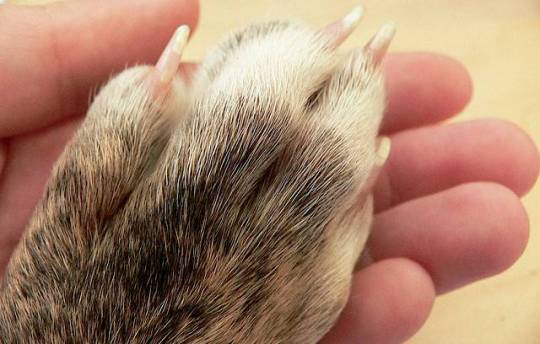
The elegant hare feet of the greyhound are responsible for the spring in their step. (Photo: Marianne Perdomo/Flickr)
15. On the other hand — er, paw — some breeds have “hare feet,” which are elongated with the two middle toes longer than the outer toes. Breeds that enjoy hare feet include some toy breeds, as well as the Samoyed, Bedlington terrier, Skye terrier, borzoi and greyhound. Their paw prints are more slender and elongated.
16. And then there’s “Frito feet.” If you notice the distinct smell of corn chips emanating from the feet of your dog, resist salivating. Because when you find out that the source of the aroma is due to bacteria and fungi, you may become mightily grossed out. Generally this doesn’t lead to complications for the dog.
17. Do you love having your hands massaged? So does your pup! According to the ASPCA, a paw massage will relax your dog and promote better circulation. They recommend rubbing between the pads on the bottom of the paw, and then rubbing between each toe.
18. Although the exact etymology isn't known for sure, the word "paw" appears to come from the Gallo-Roman root form "pauta," which is related to late 14th century Old French "patin," which means clog, as in the type of shoe. And with that in mind, we leave you with the following photo of a pup in boots (which we're guessing he jumped out of immediately after the picture was taken):

206 notes
·
View notes
Text
You wanna write about the Holocaust?
So, I got this wild idea while watching documentaries about the Holocaust tonight. Which, if you’ve been following for awhile, you’ve probably realized that Salome’s author (that would be me, lol) is a Holocaust historian. And you also probably know that I get very testy about portrayals of that narrative that romanticize the suffering of human beings (having lost my family in Stutthof and Majdanek, perhaps that’s equally unsurprising.)
This all lead me to an idea: make a post full of resources that benefit people trying to write a Holocaust narrative for legitimate purposes. If you’re are trying to have a kissypoo love story set in Auschwitz, though, please for the love of everything excuse yourself out of my post.
If you’re here because you are writing a character who has historical ties to that event, for one reason or another, or is the descendant of survivors? Well friend, YOU GON’ LEARN TODAY. And I mean, some of this is recycled from my list on Judaism-based resources, but I’m gonna get specific as fuck for y’all.
First off, let’s get a couple important bits out of the way.
UPDATED: 3/13/2017
You don’t know about Judaism at all and don’t know where to start?
The Jewish People: A Story of Survival (F)
Essential Judaism: A Complete Guide to Beliefs, Customs & Rituals, George Robinson
Living Judaism: The Complete Guide to Jewish Belief, Tradition, and Practice, Wayne D. Dosick
Judaism as a Civilization, Mordecai M. Kaplan
Not in the Heavens: The Tradition of Jewish Secular Thought, David Biale
This may also be relevant to what you’re writing, if you’re writing descendants of survivors:
Balancing on the Mechitza: Transgender in Jewish Community, Noach Dzmura
Queer Jews, David Shneer
Yentl’s Revenge: The Next Wave of Jewish Feminism, Danya Ruttenberg
Expanding the Palace of Torah: Orthodoxy and Feminism, Tamar Ross
Jewish Way in Death and Mourning, Maurice Lamm
Are the Jewish people you writing Ashkenazi (European) in descent?
Born to Kvetch: Yiddish Language and Culture in All of Its Moods, Michael Wex
Yiddish Civilisation: The Rise and Fall of a Forgotten Nation, Paul Kriwaczek
Revolutionary Yiddishland: A History of Jewish Radicalism, Alain Brossat, Sylvie Klingberg
A History of Jewish Life from Eastern Europe to America, Milton Meltzer
A History of Zionism: From the French Revolution to the Establishment of the State of Israel, Walter Laqueur
From Prejudice to Destruction: Anti-Semitism, 1700-1933, Jacob Katz
Anti-Judaism: The Western Tradition, David Nirenberg
Pogroms: Anti-Jewish Violence in Modern Russian History, John Doyle Klier & Shlomo Lambroza
Are they not?
Sephardi Family Life in the Early Modern Diaspora, Julia R. Lieberman
Jewish Culture and Society in North Africa, Emily Benichou Gottreich & Daniel J. Schroeter
Sephardic and Mizrahi Jewry: From the Golden Age of Spain to Modern Times, Zion Zohar
Jews of Spain: A History of the Sephardic Experience, Jane S. Gerber
The Beta Israel: Falasha in Ethiopia: From Earliest Times to the Twentieth Century, Steven B. Kaplan
The Black Jews of Africa: History, Religion, Identity, Edith Bruder
The Jews of Islam, Bernard Lewis
The Jews of Arab Lands in Modern Times, Norman A. Stillman
The Kaifeng Stone Inscriptions: The Legacy of the Jewish Community in Ancient China, Tiberiu Weisz
Are you going to explore the idea of how the Nazis used scientific racism against the Jews in your work? Well, it started way before the Nazis, who imported it from the Americans and Europeans so get studyin’:
Scientific Racism: The Eugenics of Social Darwinism (F)
The Human Zoo: Science’s Dirty Secret (F)
Tomorrow's Children (F; 1934 film considered immoral in its time for protesting the eugenics movement in America)
Eugenics in History (F)
The Jews: a Study of Race and Environment, Maurice Fishberg (Published in the American magazine, Popular Science, c. 1906)
War Against the Weak: Eugenics and America's Campaign to Create a Master Race, Edwin Black
Eugenics, Irving Fisher (Published in 1913 as an introduction to the philosophy of the eugenics movement in America)
Imbeciles: The Supreme Court, American Eugenics, and the Sterilization of Carrie Buck (Adam Cohen)
A Century of Eugenics in America: From the Indiana Experiment to the Human Genome Era
American Eugenics: Race, Queer Anatomy, and the Science of Nationalism, Nancy Ordover
Better for All the World: The Secret History of Forced Sterilization and America's Quest for Racial Purity, Harry Bruinius
The Nazi Connection: Eugenics, American Racism, and German National Socialism, Stefan Kuhl
The Oxford Handbook of the History of Eugenics, Alison Bashford, Philippa Levine
Need a primer for what happened during the Holocaust? I tried to make these mostly film/talks, so that they are easily accessible.
The Nazis: A Warning From History (F)
Auschwitz: A New History, Laurence Rees
Night Will Fall (F)
Engineering Evil: Inside the Holocaust (F)
‘Prostitution’ (Sexual Slavery) During the Holocaust (F)
Among the Righteous (F)
Among the Righteous: Lost Stories from the Holocaust’s Long Reach into Arab Lands, Robert Satloff
Sexual Violence against Jewish Women during the Holocaust, Sonja M. Hedgepeth
The Deaf Holocaust: The Deaf and Nazi Germany (F)
Porrajmos: The Romani and the Holocaust
Hidden Sorrows: Persecution of Roma during the Holocaust (F)
One Day in Auschwitz (F)
Science and the Swastika: The Deadly Experiment (F)
Science and the Swastika: Hitler’s Biological Soldiers (F)
Doctors from Hell: The Horrific Account of Nazi Experiments on Humans, Vivien Spitz
Hitler and the Nazi Darwinian Worldview: How the Nazi Eugenic Crusade for a Superior Race Caused the Greatest Holocaust in World History, Jerry Bergman
War and Genocide: A Concise History of the Holocaust, Doris L. Bergen
Belzec, Sobibor, Treblinka: The Operation Reinhard Death Camps, Yitzhak Arad
Ordinary Men: Reserve Police Battalion 101 and the Final Solution in Poland, Christopher R. Browning
Neighbors: The Destruction of the Jewish Community in Jedwabne, Poland, Jan T. Gross
The Good Old Days: The Holocaust as Seen by Its Perpetrators and Bystanders, Ernst Klee, Willi Dressen, Volker Riess
Hitler’s Willing Executioners: Ordinary Germans and the Holocaust, Daniel Jonah Goldhagen
The Nazi Doctors: Medical Killing and the Psychology of Genocide, Robert Jay Lifton
Then there’s the memoirs:
Night, Elie Wiesel
Survival in Auschwitz, Primo Levi
The Diary of a Young Girl, Anne Frank
Maus: A Survivor’s Tale, Art Spiegelman
Man’s Search for Meaning, Viktor E. Frankl
A Lucky Child: A Memoir of Surviving Auschwitz as a Young Boy, Thomas Buergenthal
All But My Life: A Memoir, Gerda Weissmann Klein
I Have Lived A Thousand Years: Growing Up In The Holocaust, Livia Bitton-Jackson
The Pianist: The Extraordinary True Story of One Man’s Survival in Warsaw, 1939-1945, Wladyslaw Szpilman
There Once Was a World: A 900-Year Chronicle of the Shtetl of Eishyshok, Yaffa Eliach
Are you still thinking about making a love story or some other asinine plot set in the Holocaust narrative? Do you know that distorts the memory of my people’s worst atrocity? Maybe you should learn why pushing fictional stories that minimize the suffering endured by its victims is an horrendously bad idea:
The End of the Holocaust, Alvin H. Rosenfeld
Imaginary Witness: Hollywood and the Holocaust (F)
Romanticism After Auschwitz, Sara Guyer
Remembering to Forget: Holocaust Memory through the Camera’s Eye, Barbie Zelizer
Lying About Hitler: History, Holocaust, and the David Irving Trial, Richard J. Evans
Denying the Holocaust: The Growing Assault on Truth and Memory, Deborah E. Lipstadt
Beyond Belief: The American Press And The Coming Of The Holocaust, 1933- 1945, Deborah E. Lipstadt
11 notes
·
View notes
Photo

American Eskimo Dog
The American Eskimo Dog is a breed of companion dog originating in Germany. The American Eskimo is a member of the Spitz family. The breed's progenitors were German Spitz, but due to anti-German prejudice during the First World War, it was renamed "American Eskimo Dog". Although modern American Eskimos have been exported as German Spitz Gross (or Mittel, depending on the dog's height), the breeds have diverged and the standards are significantly different. In addition to serving as a watchdog and companion, the American Eskimo dog also achieved a high degree of popularity in the United States in the 1930s and 1940s as a circus performer. There are three size varieties of the American Eskimo breed, the toy, miniature and the standard. They share a common resemblance with Japanese Spitz, Volpino Italiano, German Spitz and Samoyed dog.
More details Android, Windows
0 notes